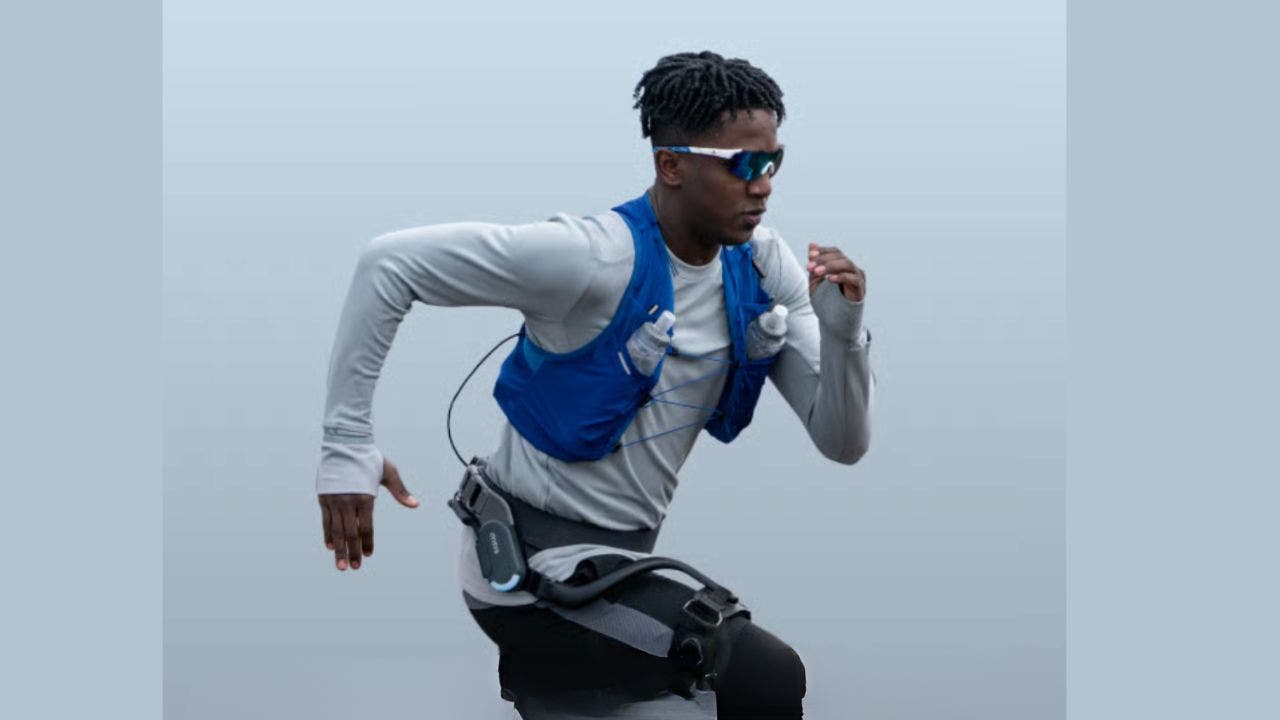Lifestyle
3 works in translation: History and literature intertwined

Meghan Collins Sullivan/NPR

Meghan Collins Sullivan/NPR
It is easy to act as if fiction and history were separate. But they cannot be completely divided.
Besides the fact that literature comes with a rich history of its own, it can give readers access to the past that is not less valuable for being, to some degree, imaginary.
Jenny Erpenbeck’s Kairos and Oksana Lutsyshyna’s Ivan and Phoebe offer this opportunity to connect with time past. Kairos takes readers into the final days of divided Germany, while Ivan and Phoebe, only a couple years and countries away, portrays the wobbly first moments of Ukraine’s post-Soviet independence. On the other hand, Françoise Sagan’s newly released The Four Corners of the Heart is a reflection of mid-20th-century French bourgeois society — but, primarily, an item of literary history: an incomplete and previously unknown work by a legendary writer. Both types of history count.
Kairos
Kairos, by the German novelist Jenny Erpenbeck, opens with a middle-aged woman named Katharina learning that her former lover, Hans, who was some 30 years older than her, has died. Very soon after, she comes home to discover that somebody has delivered two boxes of his writings to her home in Pittsburgh. Considering the boxes, she wonders, “Was it a fortunate moment… when she, just 19, first met Hans?” Kairos emerges from that question, traveling through memory to explore love and difference, the changing of historical seasons, and the crossing of borders both real and symbolic: Katharina and Hans’ romance starts in East Berlin in the final years of Germany’s division, in a moment when a starkly different future seems imminent. It would be too easy to take their relationship as an allegory for any sort of progress, and yet both the gaps between them and the nearness of their inner lives — Erpenbeck switches from his perspective to hers and back many times on each page, and often many times in a paragraph — manage to simultaneously echo and amplify the fissures between generations, and between East and West.
Erpenbeck is frequently named on lists of Nobel Prize contenders and, for newcomers to her work, Kairos easily demonstrates why. Its mix of intimacy and historical sweep is astounding. So is its prose. In poet and translator Michael Hofmann’s rigorous translation, Kairos‘ writing feels purified, as if any emotional irrelevancy had been burned out. As a result, it is devastating. In one scene, Hans and Katharina have sex to the sound of an East German May Day parade, embarking on a “private emigration on the narrow bed.” In that moment, Katharina’s departure seems all but foretold — and yet who has not experienced intimacy as a radical private departure? Here and throughout, Kairos is a voyage far from the familiar, and toward the limits of what a novel can do.
Ivan and Phoebe
The Ukrainian writer Oksana Lutsyshyna should really have called her award-winning fourth novel Ivan, not Ivan and Phoebe. Although it is nominally an exploration of a marriage, Ivan and Phoebe, translated by poet and diplomat Nina Murray, is in fact a sprawling, freewheeling journey through its protagonist Ivan’s mind, memory, and community — which does include his wife Phoebe, a young poet from his hometown, but barely. Ivan is an awful husband. He ignores Phoebe, fails to shield her from his domineering mother and, worst of all, “attempt[s] to silence her poems forever.”
Lutsyshyna gives Phoebe almost no room on the page, but the novel plainly takes her side while exploring the roots of Ivan’s misogyny and unkindness. In part, the former comes from a mix of tradition and thoughtlessness, but both are the result of trauma. As a university student in Kyiv around 1990, Ivan joined the Revolution on Granite, organizing and protesting against Soviet rule until persecution by secret police drives him home to the sleepy city of Uzhhorod. He tries to build a life there as the Soviet Union crumbles, but he’s scarred, frightened, and profoundly confused. He isn’t alone on any of these fronts. Early in the book, a man newly released from prison asks Ivan, [What’s] this independence we’ve got going on now? How am I supposed to live?” Every man in the book seems to have the same question. Many drink heavily, some fatally. Nobody, Ivan included, can sustain the patriotism that fueled the Revolution on Granite. Among the people he knows, freedom has come, in a certain sense, too late: Ukrainian history now weighs on them so heavily that “[one] could not laugh about it. One could not drink to it. One could not live with it.”
Ivan and Phoebe is, fundamentally, a moving, sympathetic portrait of a man and a community struggling through historical trauma, managing the aftershocks of seismic change as best they can. It’s worth noting that Murray’s translation is smooth, often elegant, but broken up by too many footnotes and by her decision to render Ivan’s mother’s speech in a rough approximation of dialect that verges on caricature. Still, these flaws aren’t enough to stop the book’s momentum, and sinking into Ivan’s world is both painful and a pleasure.
The Four Corners of the Heart
In 1957, the French writer Françoise Sagan, then 21 years old and already the bestselling author of Bonjour Tristesse and A Certain Smile, nearly died in a car crash outside Paris. (The New York Times reported that Sagan’s “hobby is fast sports cars… She had once been warned publicly by the Paris police to drive more carefully.”) Her injuries led to a battle with opioid addiction; still, she wrote prolifically — plays, screenplays, stories, and more than 30 novels — until her death in 2004. Such abundance raises the question of why her son Denis Westhoff decided to release an edited version of her very unfinished manuscript The Four Corners of the Heart, translated by Sophie R. Lewis. The novel centers on a bourgeois family, the Cressons, in whose household “no one… was truly concerned with anyone — other than themselves.” Their selfishness and venality are exposed after a car crash that nearly kills the adult son and heir, Ludovic. He spends three years in a variety of institutions before making an abrupt recovery. When he returns to his parents’ enormous, tacky house, he discovers that his parents are ashamed of him; his wife, Marie-Laure, is repulsed. Unsurprisingly, misery and adultery ensue.
The Four Corners of the Heart, which is perhaps half-done in terms of plot, does not have the coolness or precision of Sagan’s finished novels. Its satire is broad; its characters are cartoons and buffoons. It is evidently a draft — and although releasing it may contribute to literary history, doing so does not otherwise serve Sagan’s legacy. In his afterword, Westhoff — whose biography notes that, “Despite her outstanding debts, [he] has chosen to fight for the posterity of her life’s work” — writes that when he encountered the manuscript, its “patent weaknesses could have done real harm to my mother’s oeuvre.” He goes on to explain that he chose to revise the book only after “[s]everal voices intimated that I was the only person who could” do so. Far be it from me to speculate about whose voices those were, but it brings me some tristesse that he listened. Sagan’s many fans would do well to turn their attention elsewhere.
Lily Meyer is a writer, translator, and critic. Her first novel, Short War, is forthcoming from A Strange Object in 2024.

Lifestyle
Zip, zoom and soar in L.A.'s extraordinary new playground for bike riders

On a rainy Sunday morning in Inglewood, while most of the sprawling Edward Vincent Jr. Park was empty, one area was alive with action: the Inglewood Pumptrack. On the wavy, asphalt track that almost looks like a modern sculpture emerging out of a grassy field, kids and adults on bicycles zoomed around, showcasing tricks and testing their endurance.
Since it opened in September, the site — billed as L.A.’s first pump track — has quickly become a safe haven for bicyclists to ride, connect with others and, most important, have fun.
“This has been a game changer,” says Corey Pasowicz, who brings his 12-year-old daughter, Alexandria, to the track at least two times a month to practice her BMX and mountain biking skills. She rides on a factory team for Black Crown BMX.
A pump track is a playground for bikes filled with undulating hills, rollers, banked curves (often referred to as “berms”) and shallow jumps. Instead of pedaling or pushing the bike forward, riders do an up-and-down pumping motion with their body to maintain momentum. There are roughly 10 pump tracks in Southern California; for many years, the closest ones to L.A. were in Temecula and Thousand Oaks.
BMX athletes ride along the Inglewood track, which opened in September.
(Alisha Jucevic / For The Times)
The idea to build a pump track in Inglewood came to Eliot Jackson, a top 10 downhill mountain bike racer and top performer in the World Cup circuit, in 2020, when he started reflecting on his childhood.
Growing up in Oklahoma, Jackson and his older brother would build dirt jumps in their backyard. When the family moved to L.A., there was no place to ride that was away from vehicles, so Jackson’s mother would drive the boys to a biking track about 45 minutes away.
“A bike lane is not a safe place for kids and a lot of times sidewalks aren’t [either],” says Jackson, 33. “So I think for us, a pump track represents that first step to permanent cycling infrastructure — a place where I can say, ‘This isn’t going anywhere. … I have a place where I can go every single day, there’s community there, it’s safe [and] my parents are OK with me going there.’”
Visitors can also take Metro trains to get to the track, as it’s walking distance from the Downtown Inglewood and Fairview Heights stations.
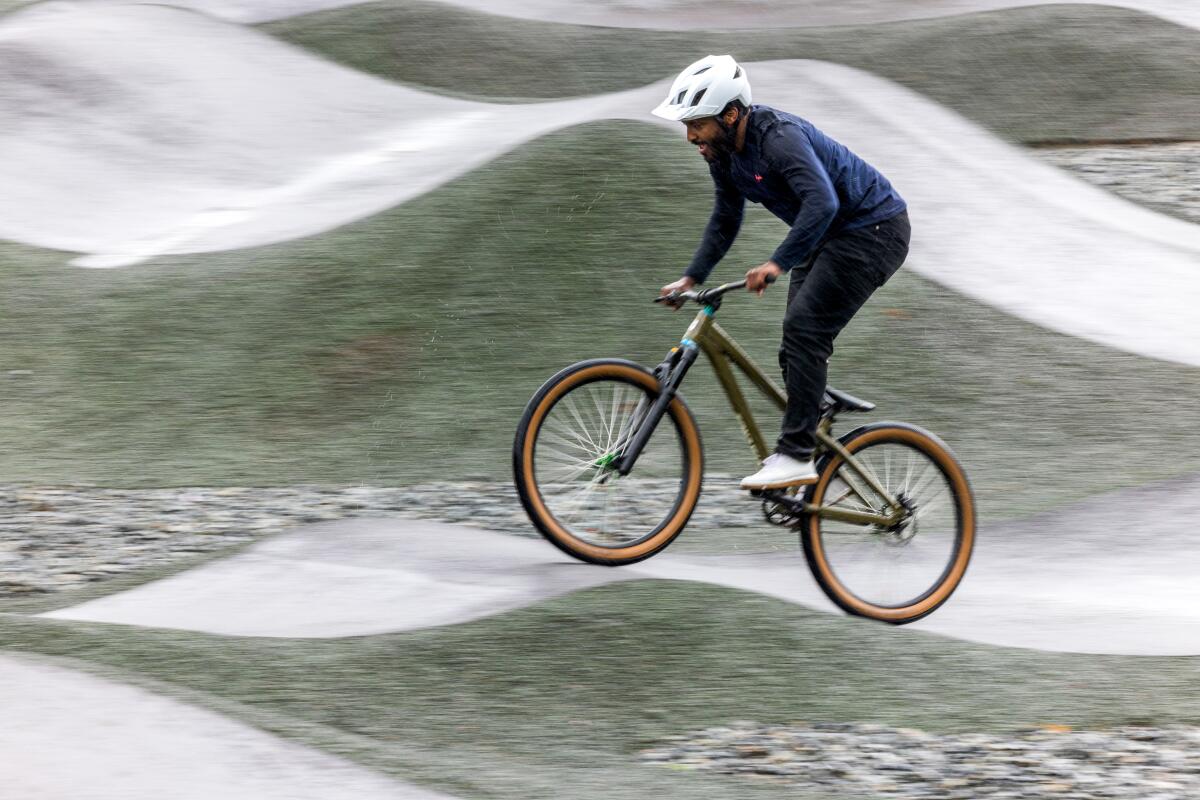
Eliot Jackson, a pro mountain biker, showcases his skills at the Inglewood Pumptrack.
(Alisha Jucevic / For The Times)
Jackson also hoped to help remedy the lack of diversity within the professional biking industry by building the track. Throughout his decade-plus long career, he was often the only Black person — or person of color — at the starting line at competitions. In August, after he retired from World Cup competition, Jackson launched the Grow Cycling Foundation, which is dedicated to making cycling more inclusive.
“I just thought about my life and all of the serendipitous things that led up to that,” says Jackson. Like his family “happening to move to California, where there’s mountains [and] my friend happening to take me up to Whistler Mountain Bike Park and introduce me [to downhill].”
“You start to think about the lack of opportunities that exist there, and I said, ‘What can I do?’” adds Jackson, who’s the chief executive of Grow Cycling, as well as a mountain bike expert for Red Bull.
The Inglewood Pumptrack, which cost $1.2 million, was fully funded by the cycling community for the cycling community with more than $300,000 in donations from individuals. The rest came from founding partners, including such brands as Yeti Cycles, Ride Fox, Pinkbike, Santa Cruz Bicycles, the Rapha Foundation and Adidas, Jackson says. (Jackson is also an ambassador for Santa Cruz Bicycles, Rapha and Fox.)
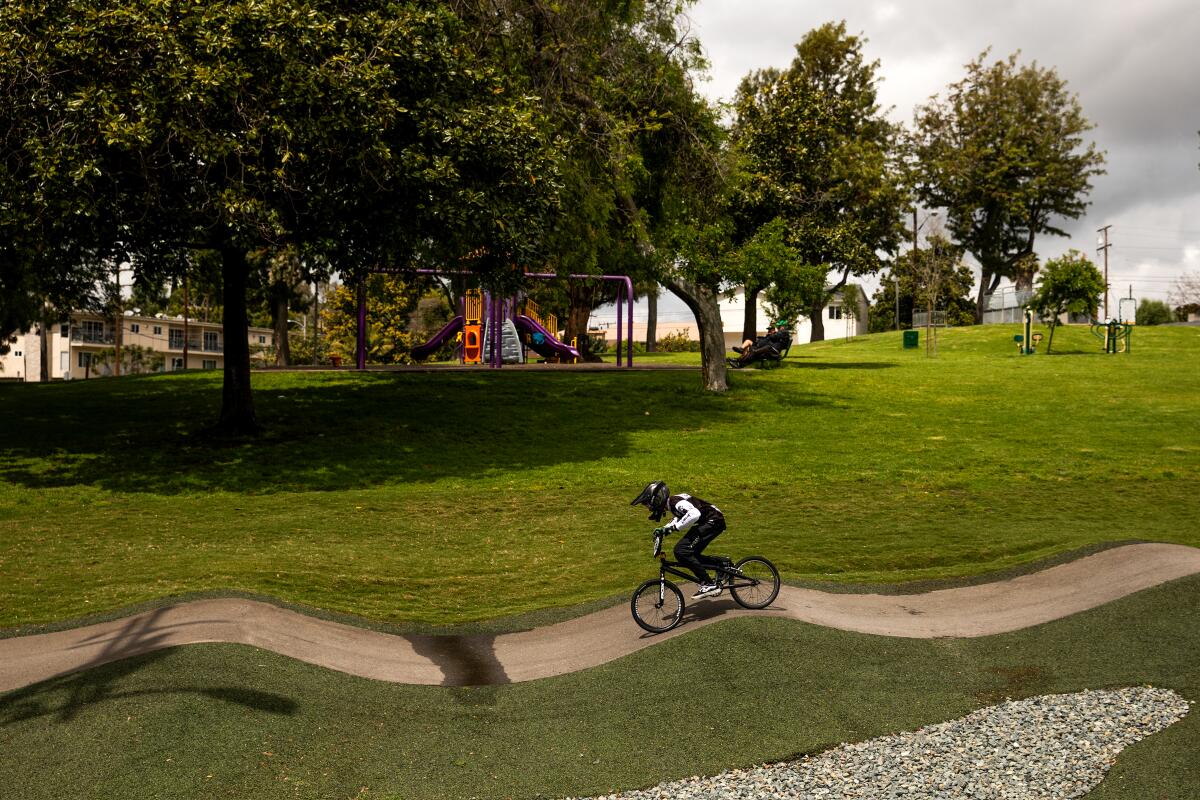
Jin Morita, 13, rides on the World Championship Track, one of two tracks at Inglewood Pumptrack at Edward Vincent Jr. Park in Inglewood.
(Alisha Jucevic / For The Times)
Constructed by Velosolutions, the site features two asphalt courses: The Woodlands and World Championship tracks. Woodlands, which is smaller and surrounds a host of trees, has smaller rollers and is designed for slower speeds. Whereas the colossus World Championship track, which is wider with large rollers, was built in a mirrored design so two riders can race in opposite directions at the same time. The design and name for this track was intentional as Jackson plans to host world championship competitions there. (Between both tracks, roughly 300 to 400 people were riding at the same time on opening day.) Both tracks are open to all ages and levels.
The Inglewood Pumptrack was specifically built with bicyclists in mind; for years, they were pushed out of skate parks and weren’t welcomed by the skateboarding community, says Joi Jackson, Eliot’s mom and the president of Grow Cycling.
They wanted to set a more inclusive precedent for bike infrastructure, so there are bike priority days at the track. Other wheels such as skateboards, longboards and rollerblades are welcome on specific days of the week. (A sign near the track entrance includes more details on this and other rules for the track.)
People who use wheelchairs or adaptive bikes can also utilize the track. However, no scooters or motorized vehicles such as e-bikes, hoverboards or electric scooters are allowed.
Ameri de Vera, 9, who rides BMX on a factory team for a company called Answer BMX, goes to the Inglewood Pumptrack at least twice a month with her older sister.
“I was scared at first because you have to get used to how it sways,” says De Vera, who was preparing for the BMX world championships on a recent Sunday. “It sways in different directions and there’s some sharp turns too. So you have to keep your eye on those, but it was really fun once I got used to it. And you can ride your skateboard on it.”

Eliot Jackson rides the Inglewood Pumptrack with BMX athletes, Ameri de Vera, 9, left, and her sister Vida de Vera, 11, center.
(Alisha Jucevic / For The Times)
For first-timers, she recommends gearing up and wearing a helmet for safety “because the first time, you’re probably going to fall.” She also encourages people to be aware of their surroundings and pay attention to what others are doing to avoid accidents.
Although there’s a skate ramp at the park, Erik Barnes, 50, says he prefers to ride on the pump track.
“There’s a proliferation of skate parks here, but none like this,” says Barnes of West Adams, who’s been an avid skateboarder since he was a teen. He sometimes brings his teenage son to the track with him.
“I meet a lot of guys my age or us older skaters who are just falling in love with this place. Everyone’s like, ‘It’s reignited skateboarding for me. It got me back into it,’ and that’s definitely the case for me.” Barnes frequents the track at least twice a week, usually before work.
What Barnes loves most about the track is that “you don’t have to be really good to enjoy this park.”
“You can kind of get yourself into a really fun zone of just cruising, which is a really pleasurable, fun thing to do,” he says. “It’s not exceedingly difficult.”
He adds, “You can just get into a nice flow. It’s rhythmic. It’s meditative and it’s a really good workout because you’re basically just doing squats the whole entire time.”
After not seeing many rollerskaters at the Inglewood Pumptrack each time they visited, Bily Ruiz, 26, started a weekly meetup called K.h.a.o.t.i.c Quads. The group, whose members range in age from 1 to 50, meet there on Sunday mornings.
“I love the community that [the track] is creating, because at some parks, the culture can be very standoffish or they don’t really talk to each other,” says Ruiz. Whereas at the Inglewood Pumptrack, “since everyone’s so excited, everyone’s like ‘What’s up? Hi. I see you. Good job.’”
“I look forward to it every weekend,” Ruiz says about about the group. “It’s so exciting, and every time we meet up, it fills me up with so much energy.”

“We built something that people love and that makes me the most happy,” says Eliot Jackson.
(Alisha Jucevic / For The Times)
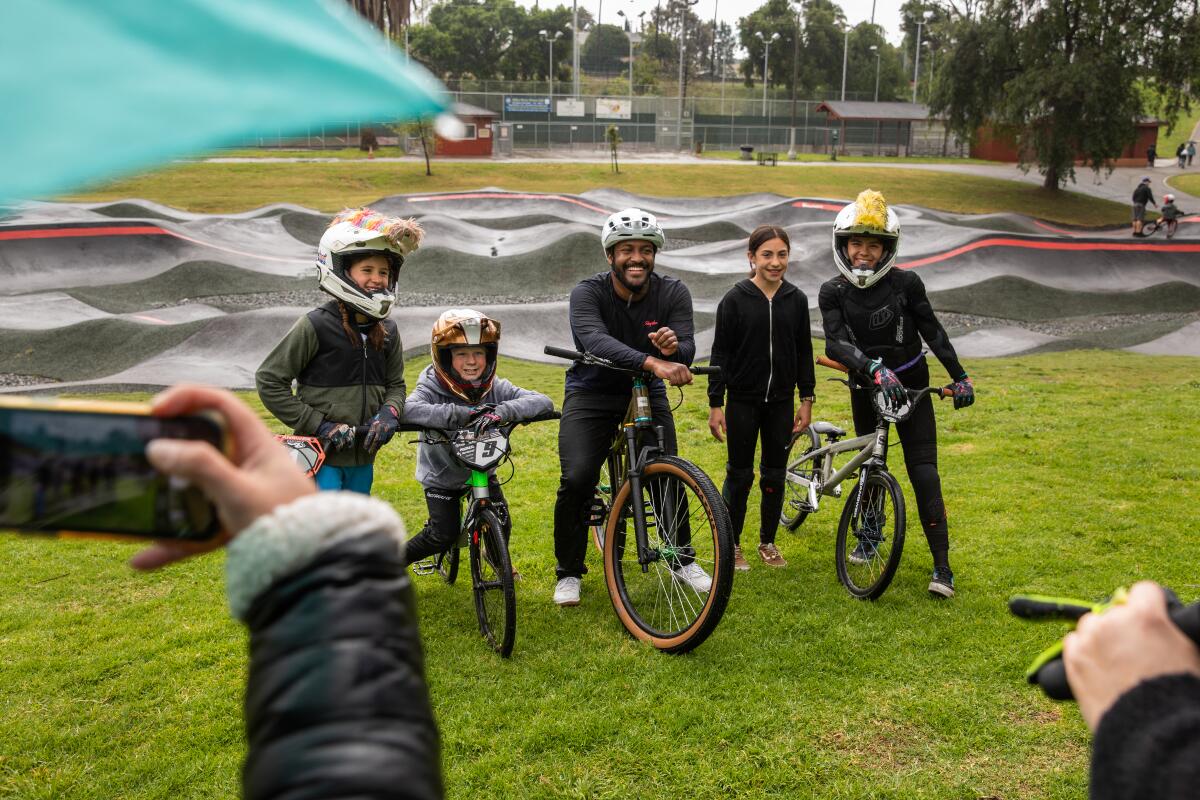
The parents of young BMX athletes take a photo of them with Eliot Jackson, center, at the Inglewood Pumptrack.
(Alisha Jucevic / For The Times)
The Grow Cycling Foundation has also donated permanent bike fleets to nearby in Inglewood elementary and middle schools , which they use for education programs. The organization views the pump track as the first step in a long-term mission to make cycling culturally relevant in the city.
In the meantime, though, Jackson says he’s enjoyed seeing kids who may have never seen or heard of a pump track before get to experience one for the first time — or simply fall back in love with riding bikes.
“We built something that people love and that makes me the most happy,” he says. “I just think about us as a family when we were growing up and my mom would’ve taken us every single day, and look at where I am now?
“And that will happen. There will be a kid who goes on to be better than I ever could because they got to discover a bicycle at this place.”
Lifestyle
Ryan Gosling is 'The Fall Guy' in this cheerfully nonsensical stuntman thriller

Ryan Gosling is Colt Seavers in The Fall Guy.
Universal Pictures
hide caption
toggle caption
Universal Pictures

Ryan Gosling is Colt Seavers in The Fall Guy.
Universal Pictures
From the 1933 action film Lucky Devils to the 1980 comedy-thriller The Stunt Man to Quentin Tarantino’s Once Upon a Time … in Hollywood, filmmakers have long delighted in turning the camera on stunt performers, those professional daredevils who risk life and limb to make action scenes look convincing.
It’s a hard, often thankless job, which is why for years people have lobbied the motion picture academy to present an Oscar for stunt work. And of course, it’s a dangerous job: Just last month, while shooting the Eddie Murphy movie The Pickup, several crew members were injured during a stunt involving two rolling cars.
There’s a lot of vehicular mayhem in the noisily diverting new action-comedy The Fall Guy, a feature-length reboot of the ’80s TV series. Ryan Gosling stars as a highly skilled stunt performer named Colt Seavers, who, despite his cynical film-noir-style voiceover, genuinely loves his job.
Colt loves movies and moviemaking, loves hurling himself off balconies and strapping himself into soon-to-be-totaled automobiles. Most of all, he loves Jody Moreno, an up-and-coming assistant director played by Emily Blunt, and she loves him right back.

Ryan Gosling and Emily Blunt star in The Fall Guy.
Universal Pictures
hide caption
toggle caption
Universal Pictures

Ryan Gosling and Emily Blunt star in The Fall Guy.
Universal Pictures
Colt works mainly as a stunt double for Tom Ryder, a world-famous movie star played by a preening Aaron Taylor-Johnson. But when Colt suffers a life-threatening injury on the set, he quits the biz in despair and ghosts Jody for more than a year while he recovers. But then he learns that Jody is directing a big-budget sci-fi movie in Sydney and wants him to be Tom’s stunt double again. Upon arriving Down Under, however, Colt finds out that Jody did not ask for him and has no idea why he’s here.
The reason for Colt’s appearance on the set is one mystery in a cheerfully nonsensical thriller plot devised by the screenwriter Drew Pearce. There’s also a body in a bathtub, an incriminating cell phone and several amusing side characters, including a busybody producer played by Hannah Waddingham of Ted Lasso fame.

Another key player is Colt’s best friend and stunt coordinator, Dan, played by the always excellent Winston Duke. In one endearing running gag, Colt and Dan keep quoting dialogue from classic films like The Last of the Mohicans, The Fugitive and The Lord of the Rings trilogy, all of which The Fall Guy giddily tries to outdo in its sheer volume of death-defying mayhem.
Before long, Colt isn’t just performing stunts. He’s forced to put his well-honed survival skills to good use off the set, whether he’s beating up thugs in a nightclub, punching villains in a helicopter or getting tossed around in the back of a speeding garbage truck. That’s one of several set-pieces that the director David Leitch opted to shoot using practical techniques, rather than CGI — a decision that gives this stunt-centric movie an undeniable integrity.

The Fall Guy is undoubtedly a passion project for Leitch, who once worked as a stunt double for actors including Brad Pitt and Jean-Claude Van Damme. (He nods to this by giving Colt a handy canine companion named Jean-Claude.) Leitch can direct action beautifully, as he did in the Charlize Theron smash-’em-up Atomic Blonde. But he can also go too flamboyantly over-the-top, as in sloppier recent efforts like Bullet Train and Hobbs & Shaw. The Fall Guy is better than those two, but it would have been better still with cleaner action, tighter editing and a running time south of two hours.

Blunt is such a good comedian and action star that it’s a shame she doesn’t get more to do in either department; Jody may be in the director’s chair, but as a character, she’s mainly a second banana. The Fall Guy is Gosling’s picture. Unlike the brooding, taciturn stuntmen the actor played in Drive and The Place Beyond the Pines, Colt is a wonderfully expressive goofball. There’s a moment here, after a fiery boat chase around Sydney Harbour, when Colt emerges triumphant from the water, clothes dripping and muscles bulging, while a euphoric cover of Kiss’ “I Was Made for Lovin’ You” surges for the umpteenth time on the soundtrack. It’s ridiculous and gloriously overwrought — and like the best-executed stunts, it comes perilously close to movie magic.
Lifestyle
Britney Spears Addresses Hotel Incident with Boyfriend, Moving to Boston

Britney Spears just addressed the hotel incident that required paramedics to rush to the scene — and she’s out here claiming “fake news” … while also vowing to head to Beantown.
The pop star hopped on IG Thursday with a telling caption, which seems to touch on exactly what happened Wednesday night — namely, first responders arriving at the Chateau Marmont after Britney and her boyfriend, Paul Soliz, got a big fight that spun out of control.

She writes, “Just to let people know … the news is fake !!! I would like respect at this time for people to understand I am getting stronger everyday !!!”

Britney goes on to say this … “Truth sucks so can someone teach me how to lie ???” She continues by explaining what sort of injuries she sustained in the argument — saying she twisted her ankle, and claiming paramedics showed up at her hotel door “illegally.”

She adds, “They never came in my room but I felt completely harassed. I’m moving to Boston!!!”
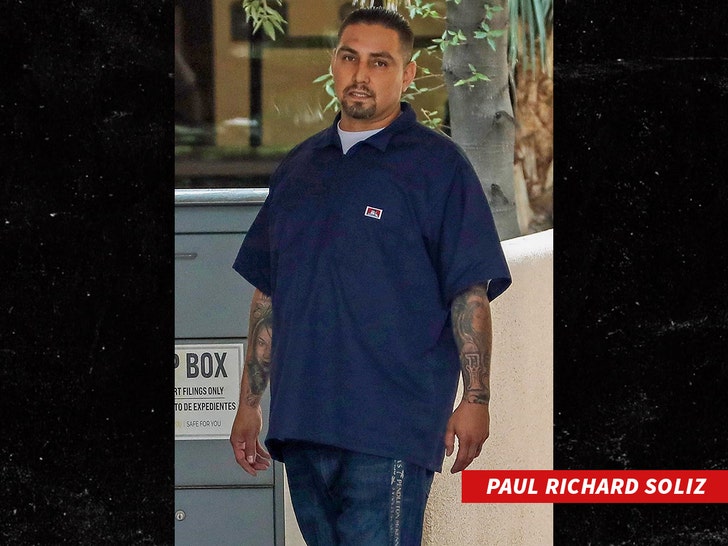
Of course, based on our reporting … we know this isn’t how things went down. As we told you — someone called cops to report a woman matching Britney’s description causing a ruckus at the hotel, allegedly bothering employees and guests.

After cops showed up and didn’t see anything was amiss — we’re told Britney and Paul hit their room, kept partying and eventually got into a scuffle … which ended with her getting injured. Paramedics were eventually called, but Britney wasn’t stretchered out.
Instead, she walked out of the building on her own two feet — but was looking rough. We’re told she didn’t leave with Paul, nor did she take an ambulance ride. She left with security.

Now, Britney is trying to downplay the whole thing — but it was ugly, no question. Of course, the larger backdrop is the fact we’ve been told she’s completely dysfunctional right now.
-

 News1 week ago
News1 week agoLarry Webb’s deathbed confession solves 2000 cold case murder of Susan and Natasha Carter, 10, whose remains were found hours after he died
-

 World1 week ago
World1 week agoHaiti Prime Minister Ariel Henry resigns, transitional council takes power
-

 News1 week ago
News1 week agoFirst cargo ship passes through new channel since Baltimore bridge collapse
-

 World1 week ago
World1 week agoUS secretly sent long-range ATACMS weapons to Ukraine
-

 World1 week ago
World1 week agoSpanish PM Pedro Sanchez suspends public duties to 'reflect'
-

 News1 week ago
News1 week agoAmerican Airlines passenger alleges discrimination over use of first-class restroom
-

 World1 week ago
World1 week agoAsia bears biggest climate-change brunt amid extreme weather: WMO
-

 Movie Reviews1 week ago
Movie Reviews1 week agoHumane (2024) – Movie Review
